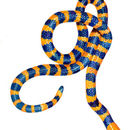en
names in breadcrumbs


From the Darien region in eastern Panama to the Pacific side of Colombia, west to the Andes.
Holotype: MNHMP 3915 Golay et al., 1993, Endogly. Venom. Snakes World 478pp.[175]
Type-locality: Col. rio-sucio ou Senio: Roze, 1967, Am. Mus. Novit. 2287:1-60[36], suggested that this might be Sinú, Colombia.
Until recently M. multifasciatus and M. hertwigi often have been placed in the synonymy of M. mipartitus (e.g., Roze In Peters and Orejas-Miranda, 1970, Bulls. U.S. Natl. Mus. 297(1):1-347[214].) Four subspecies were recognized by Roze, 1983 [dated 1982], and Campbell and Lamar, 1989, Venom. Rept. Latin America: 425pp.[132]. These subspecies are M. m. mipartitus (Duméril, Bibron, and Duméril 1854), M. m. anomalus (Boulenger, 1896), M. m. decussatus (Duméril, Bibron, and Duméril, 1854), M. m. semipartitus (Jan, 1858).
Micrurus mipartitus (red-tailed coral snake[2] or many-banded coral snake[3]) is a species of coral snake in the family Elapidae.[2] It is found in South and Central America. The redtail coral snake is common in agricultural areas in Colombia.[4] Its highly neurotoxic venom is known to cause seizures in its prey by activating nerve proteins responsible for seizures within it.[5]
Five subspecies are currently recognized:[2]
Micrurus mipartitus has a cylindrical body that can reach up to 140.6 centimeters in length.[6] They have quite small eyes upon their round heads. The black bodily rings of this species can range anywhere from 34 to 84 and are sundered by yellow or white intermediaries. The second ring on the head and 3 or 4 of the tail rings exude a red color in contrast to the white or yellow bands.[4]
Micrurus mipartitus is a species of crepuscular and nocturnal habits. During period of low rainfall, could be located underground several centimeters deep. In times of high rainfall, it is found on soil surface or where leaf litter is abundant. This coral snake lives from tropical dry forest to foggy forests and is related to human settlements in rural areas used for agriculture.[7]
The diet of M. mipartitus is mainly based on snakes (e.g., Atractus werneri, A. sanctamartae, Leptotyphlops spp.) as well as lizards (e.g., Lepidoblepharis sanctaemartae), amphisbaenids (e.g., Amphisbaena spp.), frogs, and caecilians (e.g., Caecilia guntheri). It is oviparous; about eight white-colored eggs have been recorded, which are 2.9 cm long, with an average weight of 3.1 gr. Incubation period lasts between 73–87 days, total length of the infants could vary from 20–21.9 cm and weight is around 3.3 gr.[7]
It occurs in Central America and South America.[1][2][3] Limits of its range vary by source and may include Nicaragua[3] and Costa Rica[2] in the north, although older records from Nicaragua and Costa Rica likely refer to M. multifasciatus.[2] The IUCN Redlist restricts its range to Panama, Colombia, Venezuela, and Ecuador, and possibly Peru.[1] It has also been listed from Brazil (Rondônia).[2]
The redtail coral snake has a potentially deadly neurotoxic venom, which produces a complete depolarizing muscle block.[8] Proteomics analysis of the venom components found that it contains about 60% three-finger toxins, 30% phospholipase A2, and 10% other toxins.[9] The most abundant venom component is the three-finger toxin mipartoxin-I.[10]
The venom acts by blocking the neuromuscular transmission of nerve muscle preparations, it acts in a post-synaptic way through the Nicotinic acetylcholine receptor (nAChr), inhibiting the muscle contractions in phrenic nerve diaphragm.[11] After the bite, local pain and paraesthesia appear in minutes, in severe cases, neurological manifestations appear in 30 minutes to 1–2 hours, such as progressive bilateral ptosis, dysarthria, progressive weakness in the muscles of the extremities, difficulties in walking, salivation, drowsiness, respiratory arrest, flaccid quadriparesis and severe flaccid quadriplegia. The LD50 for 18-20 gram mice is 9 μg and 0.45 mg / kg. The intraperitoneal lethal dose is 0.125 mg / kg and 0.06 μg / g. [12][13]
Micrurus mipartitus (red-tailed coral snake or many-banded coral snake) is a species of coral snake in the family Elapidae. It is found in South and Central America. The redtail coral snake is common in agricultural areas in Colombia. Its highly neurotoxic venom is known to cause seizures in its prey by activating nerve proteins responsible for seizures within it.